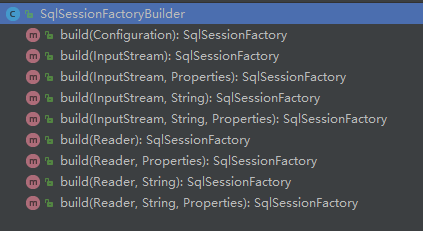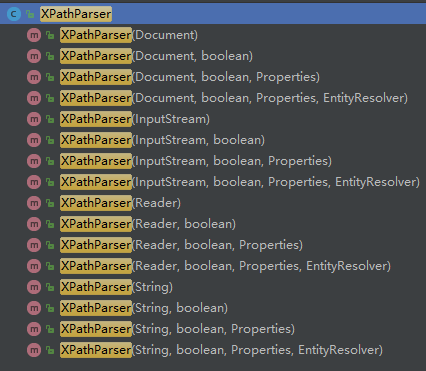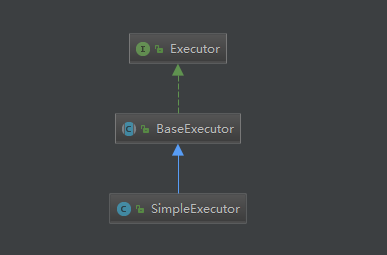MyBatis 的初始化工作就是解析主配置文件,映射配置文件以及註解信息。 ...

前言
MyBatis 作為目前最常用的持久層框架之一,分析其源碼,對我們的使用過程中可更好的運用它。本系列基於mybatis-3.4.6進行分析。
MyBatis 的初始化工作就是解析主配置文件,映射配置文件以及註解信息。然後保存在org.apache.ibatis.session.Configuration,供後期執行數據請求的相關調用。
Configuration 里有大量配置信息,在後面每涉及到一個相關配置,會進行詳細的分析。
啟動
public static void main(String[] args) throws IOException {
// 獲取配置文件
Reader reader = Resources.getResourceAsReader("mybatis-config.xml");
// 通過 SqlSessionFactoryBuilder 構建 sqlSession 工廠
SqlSessionFactory sqlSessionFactory = new SqlSessionFactoryBuilder().build(reader);
// 獲取 sqlSession 實例
SqlSession sqlSession = sqlSessionFactory.openSession();
reader.close();
sqlSession.close();
}分析
SqlSessionFactoryBuilder 類
SqlSessionFactoryBuilder 的build()是Mybatis啟動的初始化入口,使用builder模式載入配置文件。
通過查看該類,使用方法重載,有以下9個方法:

方法重載最終實現處理的方法源碼如下:
public SqlSessionFactory build(Reader reader, String environment, Properties properties) {
try {
// 實例化 XMLConfigBuilder,用於讀取配置文件信息
XMLConfigBuilder parser = new XMLConfigBuilder(reader, environment, properties);
// 解析配置信息,保存到 Configuration
return build(parser.parse());
} catch (Exception e) {
throw ExceptionFactory.wrapException("Error building SqlSession.", e);
} finally {
ErrorContext.instance().reset();
try {
reader.close();
} catch (IOException e) {
// Intentionally ignore. Prefer previous error.
}
}
}- environment 是指定載入環境,預設值為 null。
- properties 是屬性配置文件,預設值為 null。
同時讀取配置文件既可字元流讀取,也支持位元組流讀取。
public SqlSessionFactory build(InputStream inputStream, String environment, Properties properties) {
try {
XMLConfigBuilder parser = new XMLConfigBuilder(inputStream, environment, properties);
return build(parser.parse());
} catch (Exception e) {
throw ExceptionFactory.wrapException("Error building SqlSession.", e);
} finally {
ErrorContext.instance().reset();
try {
inputStream.close();
} catch (IOException e) {
// Intentionally ignore. Prefer previous error.
}
}
}實例化 XMLConfigBuilder 類
通過 SqlSessionFactoryBuilder 中 XMLConfigBuilder parser = new XMLConfigBuilder(reader, environment, properties), 分析 XMLConfigBuilder實例化過程。
該類中有四個變數:
private boolean parsed;
private final XPathParser parser;
private String environment;
private final ReflectorFactory localReflectorFactory = new DefaultReflectorFactory();- parsed 是否解析,一次解析即可。用於標誌配置文件只解析一次,
true為已解析過。 - parser 解析配置的解析器
- environment 載入環境,即
SqlSessionFactoryBuilder中的environment - localReflectorFactory 用於創建和緩存
Reflector對象,一個類對應一個Reflector。因為參數處理、結果映射等操作時,會涉及大量的反射操作。DefaultReflectorFactory實現類比較簡單,這裡不再進行講解。
XMLConfigBuilder構建函數實現:
public XMLConfigBuilder(Reader reader, String environment, Properties props) {
this(new XPathParser(reader, true, props, new XMLMapperEntityResolver()), environment, props);
}實例化 XPathParser 對象
首先實例化 XPathParser 對象,裡面定義了5個變數:
private final Document document;
private boolean validation;
private EntityResolver entityResolver;
private Properties variables;
private XPath xpath;- document 保存document對象
- validation xml解析時是否驗證文檔
- entityResolver 載入dtd文件
- variables 配置文件定義
的值 - xpath Xpath對象,用於對XML文件節點的操作
XPathParser 對象構造函數有:

函數裡面都處理了兩件事:
public XPathParser(Reader reader, boolean validation, Properties variables, EntityResolver entityResolver) {
commonConstructor(validation, variables, entityResolver);
this.document = createDocument(new InputSource(reader));
}- 初始化賦值,和創建
XPath對象,用於對XML文件節點的操作。
private void commonConstructor(boolean validation, Properties variables, EntityResolver entityResolver) {
this.validation = validation;
this.entityResolver = entityResolver;
this.variables = variables;
// 創建Xpath對象,用於對XML文件節點的操作
XPathFactory factory = XPathFactory.newInstance();
this.xpath = factory.newXPath();
}- 創建
Document對象並賦值到document變數, 這裡屬於Document創建的操作,不再詳細講述,不懂可以點擊這裡查看API
private Document createDocument(InputSource inputSource) {
// important: this must only be called AFTER common constructor
try {
// 實例化 DocumentBuilderFactory 對象,用於創建 DocumentBuilder 對象
DocumentBuilderFactory factory = DocumentBuilderFactory.newInstance();
// 是否校驗文檔
factory.setValidating(validation);
// 設置 DocumentBuilderFactory 的配置
factory.setNamespaceAware(false);
factory.setIgnoringComments(true);
factory.setIgnoringElementContentWhitespace(false);
factory.setCoalescing(false);
factory.setExpandEntityReferences(true);
// 創建 DocumentBuilder
DocumentBuilder builder = factory.newDocumentBuilder();
builder.setEntityResolver(entityResolver);
builder.setErrorHandler(new ErrorHandler() {
@Override
public void error(SAXParseException exception) throws SAXException {
throw exception;
}
@Override
public void fatalError(SAXParseException exception) throws SAXException {
throw exception;
}
@Override
public void warning(SAXParseException exception) throws SAXException {
}
});
// 載入文件
return builder.parse(inputSource);
} catch (Exception e) {
throw new BuilderException("Error creating document instance. Cause: " + e, e);
}
}XMLConfigBuilder構造函數賦值
private XMLConfigBuilder(XPathParser parser, String environment, Properties props) {
super(new Configuration());
ErrorContext.instance().resource("SQL Mapper Configuration");
this.configuration.setVariables(props);
this.parsed = false;
this.environment = environment;
this.parser = parser;
}- 初始化父類
BaseBuilder的值。 - 將外部值賦值給對象。
- 將實例化的
XPathParser賦值給parser。
最後返回XMLConfigBuilder對象。
解析 XMLConfigBuilder 對象
通過 XMLConfigBuilder.parse() 解析配置信息,保存至Configuration。解析詳解在後面文章中進行分析。
public Configuration parse() {
// 是否解析過配置文件
if (parsed) {
throw new BuilderException("Each XMLConfigBuilder can only be used once.");
}
// 標誌解析過,定義為 true
parsed = true;
// 解析 configuration 節點中的信息
parseConfiguration(parser.evalNode("/configuration"));
return configuration;
}創建 SqlSessionFactory
DefaultSqlSessionFactory實現了SqlSessionFactory介面。
通過上面解析得到的Configuration,調用SqlSessionFactoryBuilder.build(Configuration config)創建一個 DefaultSqlSessionFactory。
public SqlSessionFactory build(Configuration config) {
return new DefaultSqlSessionFactory(config);
}實例化DefaultSqlSessionFactory的過程,就是將Configuration傳遞給DefaultSqlSessionFactory成員變數configuration。
public DefaultSqlSessionFactory(Configuration configuration) {
this.configuration = configuration;
}創建 SqlSession
通過調用SqlSessionFactory.openSession()創建SqlSession。
public interface SqlSessionFactory {
// 預設創建
SqlSession openSession();
SqlSession openSession(boolean autoCommit);
SqlSession openSession(Connection connection);
SqlSession openSession(TransactionIsolationLevel level);
SqlSession openSession(ExecutorType execType);
SqlSession openSession(ExecutorType execType, boolean autoCommit);
SqlSession openSession(ExecutorType execType, TransactionIsolationLevel level);
SqlSession openSession(ExecutorType execType, Connection connection);
Configuration getConfiguration();
}- autoCommit 是否自動提交事務,
- level 事務隔離級別(共5個級別), 可查看相關源碼
- connection 連接
- execType 執行器的類型:
SIMPLE(不做特殊處理),REUSE(復用預處理語句),BATCH(會批量執行)
因為上面DefaultSqlSessionFactory實現了SqlSessionFactory介面,所以進入到DefaultSqlSessionFactory查看openSession()。
public SqlSession openSession() {
return openSessionFromDataSource(configuration.getDefaultExecutorType(), null, false);
}openSession()方法最終實現代碼如下:
private SqlSession openSessionFromDataSource(ExecutorType execType, TransactionIsolationLevel level, boolean autoCommit) {
Transaction tx = null;
try {
// 獲取configuration中的載入環境
final Environment environment = configuration.getEnvironment();
// 獲取事務工廠
final TransactionFactory transactionFactory = getTransactionFactoryFromEnvironment(environment);
// 創建一個事務
tx = transactionFactory.newTransaction(environment.getDataSource(), level, autoCommit);
// 生成一個處理器,事務保存在處理器 BaseExecutor 中
final Executor executor = configuration.newExecutor(tx, execType);
// 實例化一個 DefaultSqlSession,DefaultSqlSession實現了SqlSession介面
return new DefaultSqlSession(configuration, executor, autoCommit);
} catch (Exception e) {
// 異常情況下關閉事務
closeTransaction(tx); // may have fetched a connection so lets call close()
throw ExceptionFactory.wrapException("Error opening session. Cause: " + e, e);
} finally {
// 充值錯誤實例上下文
ErrorContext.instance().reset();
}
}生成處理器Configuration.newExecutor(Transaction transaction, ExecutorType executorType):
public Executor newExecutor(Transaction transaction, ExecutorType executorType) {
// 預設為 ExecutorType.SIMPLE
executorType = executorType == null ? defaultExecutorType : executorType;
executorType = executorType == null ? ExecutorType.SIMPLE : executorType;
Executor executor;
if (ExecutorType.BATCH == executorType) {
executor = new BatchExecutor(this, transaction);
} else if (ExecutorType.REUSE == executorType) {
executor = new ReuseExecutor(this, transaction);
} else {
executor = new SimpleExecutor(this, transaction);
}
if (cacheEnabled) {
executor = new CachingExecutor(executor);
}
executor = (Executor) interceptorChain.pluginAll(executor);
return executor;
}以ExecutorType.SIMPLE為例, BatchExecutor, ReuseExecutor同理:

至此,mybatis的啟動流程大致簡單的介紹到這裡,對mybatis的啟動初始化有個大致瞭解。接下將會針對單獨模塊進行詳細分析。
個人博客: https://ytao.top
我的公眾號 ytao



